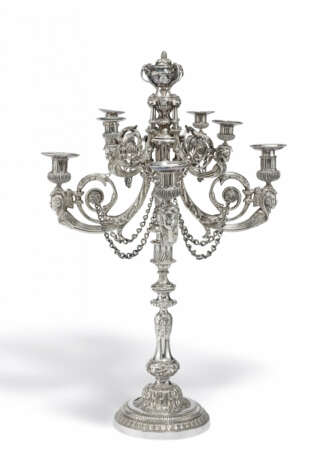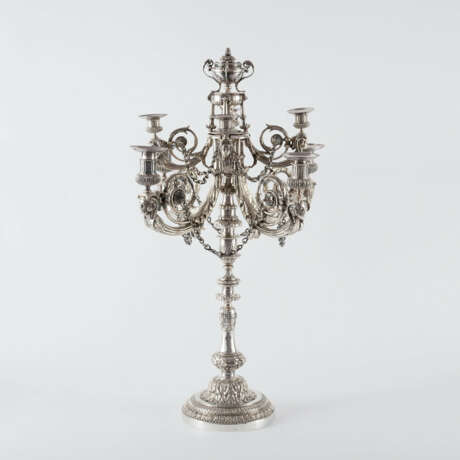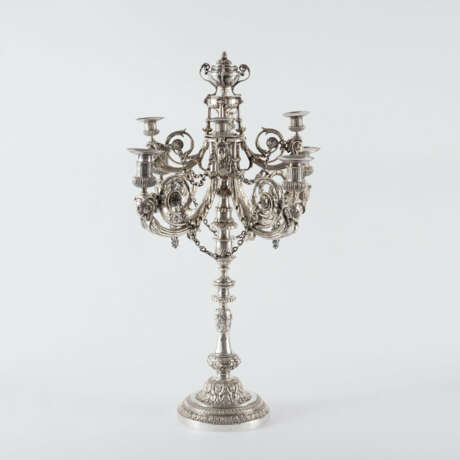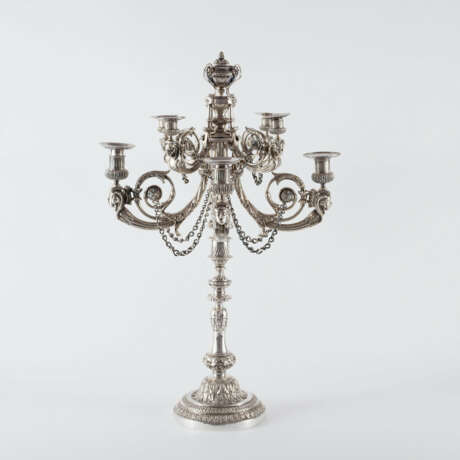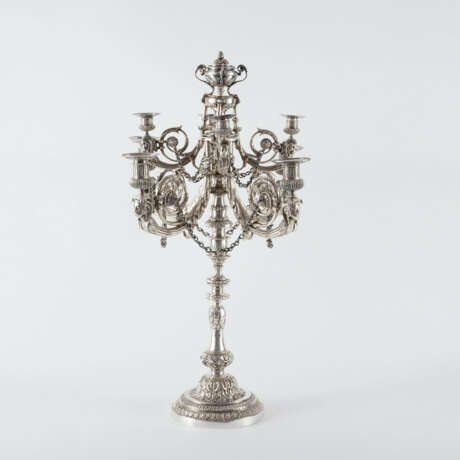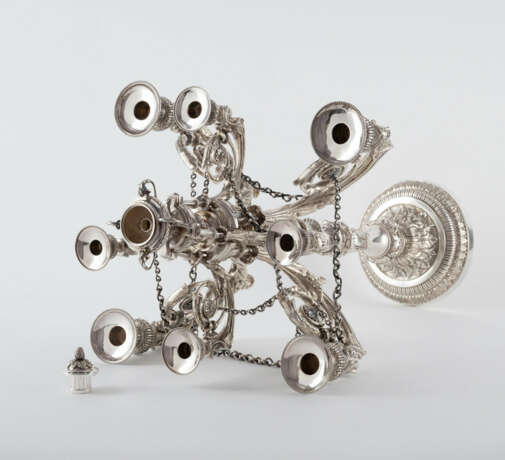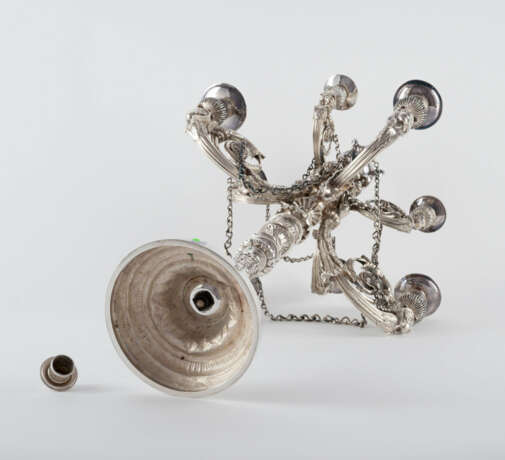Carl Daniel Heinrich Schomaker. LARGE SILVER GIRANDOLE FROM THE SILVER WARE OF GRAND DUKE FREDERICK FRANCIS IV. OF MECKLENBURG-SCHWERIN
12.11.2024 11:00UTC +01:00
Classic
Starting price
12000EUR € 12 000
| Auctioneer | VAN HAM Kunstauktionen GmbH |
|---|---|
| Event location | Germany, Köln |
| Buyer Premium | 32% |
Archive
The auction is completed. No bids can be placed anymore.

ID 1317807
Lot 16 | Carl Daniel Heinrich Schomaker. LARGE SILVER GIRANDOLE FROM THE SILVER WARE OF GRAND DUKE FREDERICK FRANCIS IV. OF MECKLENBURG-SCHWERIN
Estimate value
€ 12 000 – 14 000
Schomaker, Carl Daniel Heinrich. Schwerin.
Date: 1904.
Maker/Designer: Model presumably Prof. Otto Rohloff, Berlin.
Technique: Silver.
Description: Sturdy round base with acanthus and godrones decor and bell-shaped domed centre. Slender,
baluster-shaped shaft with rich relief decor. Topped by a large, two-row candelabra with a
total of eight twisted acanthus arms. These end in female heads with Egyptian headdresses,
on each of which are large vase bowls with inserted drip trays. The arms are connected to
each other by link chains. The centre of the centrepiece is crowned by another richly
worked vase. The lid with peg knob is removable and can be used as an additional candle
spout.
Weight: Ca. 8.010g.
Measurement: Height 72cm, ø upper section ca. 45cm.
Mark: Crescent & crown, 800 standard silver, manufacture mark Schomaker (Carl Daniel Heinrich Schomaker, from ca. 1913 court goldsmith, Scheffler, Central and North Germany).
Heavily silver-plated.
Provenance:
- Christie's Amsterdam, The European Noble House Sale, December 2003, lot 200.
- Auction VAN HAM Cologne, 2016, lot 1353.
- German private collection.
Literature:
Erinnerungsblätter der Festwoche 5.-11. Juli 1904 zu Schwerin i.M.: Die Festwoche in Schwerin zur Feier des Einzugs Sr. Königlichen Hoheit des Großherzogs Friedrich Franz IV. und seiner hohen Gemahlin Alexandra geb. Herzogin zu Braunschweig-Lüneburg. The present girandole is depicted: p. 21 and 22.
The design and details of the chandelier can be traced back to the so-called 'Russian tureens', which came to Schwerin from Russia through marriage to the House of Mecklenburg. Friedrich Ludwig, born in 1778, Hereditary Grand Duke of Mecklenburg-Schwerin since 1815, married Grand Duchess Helene Paulowna, daughter of Emperor Paul of Russia, in 1799. Her trousseau included two mighty tureens on presentation plinths, which were part of a magnificent silver dinner service created by Berthold Christian Schlepper in St. Petersburg in 1774. For the forthcoming wedding of Grand Duke Friedrich Franz IV to Alexandra Duchess of Brunswick and Lüneburg, Royal Princess of Great Britain, in 1904, the Mecklenburg knightly estates decided to have two large jardinieres on presentation bases and four 'candelabra' modelled on the 'Russian tureens' and to present them to the royal couple as a gift. Prof Otto Rohloff, one of the best chisellers and metal craftsmen in Germany and supplier to Kaiser Wilhelm II, was commissioned to design the gift. Rohloff had the jardinieres made and chiselled in Berlin. The four candelabra were made by court jeweller Heinrich Rose in Schwerin. On 10th May 1904, the citizens' committee of the city of Schwerin approved 5,000 marks for a gift from the city to the Grand Ducal couple. Just four weeks later, on 29th June 1904, the magistrate announced that the gift 'consisting of two six-armed candelabras and two silver tureens' could be viewed in goldsmith Jost's shop. The gift was presented to the Grand Ducal couple on 6th July 1904. A picture of the gift can be found in the memorial book. The gift from the city of Schwerin is stylistically very similar to the candelabras and jardinieres of the knighthood, so it can be assumed that Otto Rohloff also provided the designs for these. The girandole offered here was presented to the Grand Ducal couple by members of the Mecklenburg royal family.
| Address of auction |
VAN HAM Kunstauktionen GmbH Hitzelerstr. 2 50968 Köln Germany | ||||||||||||||
|---|---|---|---|---|---|---|---|---|---|---|---|---|---|---|---|
| Preview |
| ||||||||||||||
| Phone | +49 221 92586215 | ||||||||||||||
| Fax | +49 221 92 58 62 4 | ||||||||||||||
| Buyer Premium | 32% | ||||||||||||||
| Conditions of purchase | Conditions of purchase | ||||||||||||||
| Business hours | Business hours
|
